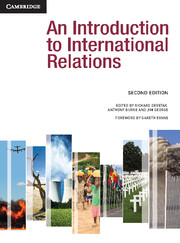Book contents
- Frontmatter
- Contents
- Tables, Figures and Boxes
- Contributors
- Preface and acknowledgements
- An Introduction to International Relations: The origins and changing agendas of a discipline
- 1 Theories of International Relations
- 2 The Traditional Agenda
- 3 The New Agenda
- 21 The United Nations
- 22 Non-State Actors: Multinational Corporations and International Non-Governmental Organisations
- 23 Religion and Secularism
- 24 Global Economic Institutions
- 25 Global Trade
- 26 Global Finance
- 27 Global Poverty, Inequality and Development
- 28 Globalisation and Its Critics
- 29 Global Terrorism
- 30 Post-Conflict State-Building
- 31 Humanitarian Intervention
- 32 Human Rights
- 33 Migration and Refugees
- 34 Global Environmental Politics
- 35 Climate Change
- Glossary of Terms
- Bibliography
- Index
- References
34 - Global Environmental Politics
from 3 - The New Agenda
- Frontmatter
- Contents
- Tables, Figures and Boxes
- Contributors
- Preface and acknowledgements
- An Introduction to International Relations: The origins and changing agendas of a discipline
- 1 Theories of International Relations
- 2 The Traditional Agenda
- 3 The New Agenda
- 21 The United Nations
- 22 Non-State Actors: Multinational Corporations and International Non-Governmental Organisations
- 23 Religion and Secularism
- 24 Global Economic Institutions
- 25 Global Trade
- 26 Global Finance
- 27 Global Poverty, Inequality and Development
- 28 Globalisation and Its Critics
- 29 Global Terrorism
- 30 Post-Conflict State-Building
- 31 Humanitarian Intervention
- 32 Human Rights
- 33 Migration and Refugees
- 34 Global Environmental Politics
- 35 Climate Change
- Glossary of Terms
- Bibliography
- Index
- References
Summary
Introduction
This chapter will introduce three of the most prominent global environmental discourses: sustainable development, environmental security and environmental justice. It begins by tracking the emergence of environmental problems as a ‘global’ political problem and tracing the discursive shift from ‘limits to growth’ in the early 1970s to sustainable development in the 1980s. It then highlights the environmental challenges of the post-Cold War period and introduces the discourses of environmental justice and ecological security. This is followed by a brief introduction to the different ways in which the basic questions of global environmental politics have been addressed by the three broad traditions of international relations: realism, liberalism and critical theory. Finally, the chapter turns to contemporary challenges, focusing on the failure of the US to take a leadership role in tackling the most serious global environmental problem of all – global warming.
The study of global environmental politics has emerged as a problem-oriented and multidisciplinary field of inquiry that seeks to understand: (a) how and why global ecological problems arise and persist; (b) how ecological risks are distributed through space and time; and (c) how the global community (encompassing states and non-state actors) has responded, or ought to respond. These three basic questions frame the field of inquiry of global environmental politics. They also signal the enormous political challenges facing international and transnational collective efforts to protect the Earth’s ecosystems and climate in a world of 193 sovereign states with vast disparities in capacity, resource endowments, population, cultures and levels of economic development.
- Type
- Chapter
- Information
- An Introduction to International Relations , pp. 462 - 474Publisher: Cambridge University PressPrint publication year: 2011
References
- 2
- Cited by

